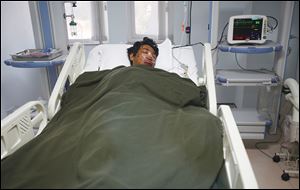
TRAGEDY AT 21,000 FEET
12 die in avalancheon Mount Everest
More missing in peak’s deadliest accident
4/19/2014
A Nepalese Sherpa, Dawa Tashi, who was injured during the avalanche, gets treat-ment at a hospital in Kathmandu, Nepal. The avalanche swept down Mount Everest early Friday, killing at least 12 Nepalese guides. Four people are missing.
Pocked with ice mounds and crevasses, the area known as the “popcorn field” is a well-traveled piece of real estate on the approach to the summit of Mount Everest.
“If you’re climbing Everest, you must go through that area,” said Michael Kobold, owner of Kobold Expedition Tools near Pittsburgh. He has twice made it to the summit of Everest. “Sir Edmund Hillary had to go that way. The ice fall is inherently dangerous — anyone who has ever climbed from the south side had to go through that way.”
A large avalanche Friday morning claimed the lives of at least 12 Sherpas who were setting up ropes in that same area to prepare for the Everest climbing season. Four other Sherpas are still believed to be missing in the deadliest accident in Everest history.
The area hit by the avalanche is just below Camp 2, Ang Tshering of the Nepal Mountaineering Association told the Associated Press. Camp 2 sits at an elevation of 21,000 feet on the 29,029-foot mountain.
Ever since Everest was first summited in 1953, the safety of Sherpas has been a shadow on mountain success stories.
An Outside magazine article last year stated that Sherpas working above Base Camp are 10 times more likely to die than commercial fishermen — the most dangerous profession in the United States.
During Mr. Kobold’s ascent to the top of Everest in 2010, one of his Sherpa guides, Ang Namgel Sherpa, nearly fell off the mountain when he sat down to put on his backpack and fell backward.
“If he had slipped 2 more feet, he would have fallen 9,000 feet and died,” he said. “It was the exact same spot where his father had died 18 years earlier.”
Mr. Kobold said Mr. Namgel and another guide, Lakpa Thundu Sherpa, saved his life on the way up the mountain when his supplemental oxygen wasn’t working.
The Sherpas also saved the life of Mr. Kobold’s wife, Anita Kobold, finding an adrenaline syringe after she had collapsed and been pronounced dead by a doctor.
The Sherpas had been fascinated watching Mr. Kobold make watches as he waited to ascend Everest, and after the harrowing climb of 2010 he became determined to provide them with a safer career option.
Mr. Kobold, 35, who lives on a farm near Grove City, Pa., brought Mr. Namgul and Mr. Thundu to Pittsburgh for nearly a year in 2011 to train them to make watches. It was slow going at first, with the men hardly speaking any English.
But eventually they became skilled enough to go back to Nepal and run their own Kobold outpost there.
Watches such as the Kobold Himalaya, made by the two Sherpas in Nepal, sell on the Kobold Web site for nearly $3,000.
Mr. Kobold drew some criticism last year after Kobold’s $16,500 Himalaya Edition watch was unveiled, featuring a face made with rocks from near Everest’s summit — removal of which is technically forbidden.
Mr. Kobold dismissed that criticism, saying that virtually all Everest climbers take rocks and that the Nepalese government regularly gives rocks as gifts to visiting heads of state.
Mr. Kobold plans to open the Kathmandu Watchmaking Institute in Nepal next year, which will train 30 to 50 Sherpas per year in a one-year watchmaking program.
The Sherpa people are one of the main ethnic groups in Nepal’s alpine region, and many make their living as climbing guides.
More than 4,000 climbers have summited Everest since 1953, when it was first conquered by Sir Edmund and Sherpa Tenzing Norgay. Hundreds have died attempting to reach the peak.
The worst recorded disaster on Everest had been a snowstorm on May 11, 1996, that caused the deaths of eight climbers. Six Nepalese guides were killed in an avalanche in 1970.
The Block News Alliance consists of The Blade and the Pittsburgh Post-Gazette. Anya Sostek is a reporter for the Post-Gazette.
Contact Anya Sostek at asostek@post-gazette.com or 412-263-1308.